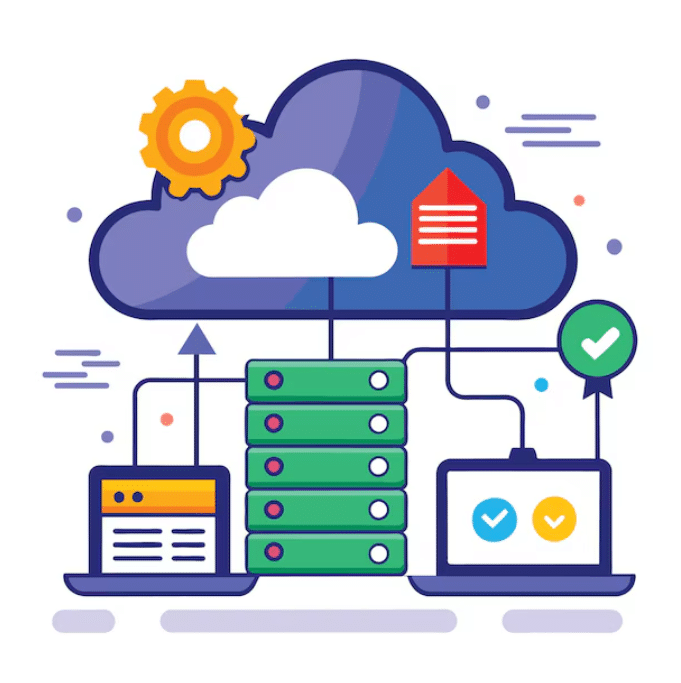Cloud Backup Server – In today’s digital world, data is the backbone of every business, institution, and even household. Whether it’s critical documents, multimedia files, or system information, the loss of such data can be catastrophic. As a result, data backup has evolved from a precaution to a necessity.
Among the most efficient and scalable solutions is the cloud backup server—a system that enables users to store copies of their data remotely via the internet, providing both safety and accessibility. This article explores what a cloud backup server is, how it works, its benefits, types, pricing models, security concerns, and how to choose the right one for your needs.

What is a Cloud Backup Server?
A cloud backup server is a remote server used to store digital data securely over the internet. It works by automatically or manually uploading files, system images, or databases to an offsite cloud infrastructure, ensuring that your information is retrievable in case of hardware failure, human error, cyberattack, or natural disaster.
Unlike traditional backups to external hard drives or tapes, cloud backups offer real-time or scheduled data protection, accessible from anywhere with an internet connection.
In essence, a cloud backup server acts as a digital insurance policy for your data.
How Does a Cloud Backup Server Work?
The process is straightforward yet robust:
-
Data Selection: You choose which files, folders, or systems need backing up.
-
Data Compression: Files are compressed to save bandwidth and storage space.
-
Encryption: Data is encrypted locally before transmission to ensure privacy.
-
Upload to Cloud Server: The data is securely sent to the backup server over the internet.
-
Storage in Data Centers: Your data resides in geographically diverse, redundant servers.
-
Scheduled Updates: Backups are scheduled to run automatically—daily, hourly, or in real time.
Why Use a Cloud Backup Server?
Here are compelling reasons to use cloud-based backup servers:
✅ Automatic and Continuous Backup
Cloud backup systems automate the backup process, ensuring that your data is always up to date without manual intervention.
✅ Remote Accessibility
Data can be accessed and restored from anywhere, whether you’re in the office, at home, or halfway across the globe.
✅ Scalability
Need more storage? Cloud systems scale with your needs without requiring new hardware purchases.
✅ Disaster Recovery
In the event of data loss due to malware, fire, flood, or hardware failure, cloud backups allow quick recovery with minimal downtime.
✅ Cost-Effective
No need for expensive infrastructure or IT personnel. You pay for what you use, and upfront costs are minimal.
✅ Security and Redundancy
Data is stored in multiple redundant locations with encryption protocols, making it highly secure and resilient.
Types of Cloud Backup Servers
Cloud backup servers can be categorized based on usage, architecture, or deployment method.
1. Personal vs. Business Backup Servers
-
Personal: Designed for individuals who want to back up photos, documents, or small media libraries.
-
Business: Tailored for servers, databases, employee files, and application data. Often includes compliance, support, and integration tools.
2. Public vs. Private vs. Hybrid Cloud Backup
-
Public Cloud: Hosted by third-party providers like AWS, Azure, or Backblaze.
-
Private Cloud: Hosted on-premises or via dedicated infrastructure for higher control and security.
-
Hybrid Cloud: Combines local and cloud storage for optimal speed and reliability.
3. File-Level vs. Image-Based Backup
-
File-Level: Backs up individual files and folders.
-
Image-Based: Takes a snapshot of the entire system (OS, apps, settings) for full recovery.
Key Features to Look For
When choosing a cloud backup server, consider the following features:
🔐 Encryption and Security
Ensure the service offers end-to-end encryption, both in transit and at rest. Zero-knowledge encryption (where even the provider can’t see your data) is a bonus.
🔁 Versioning and Retention Policies
Look for a provider that supports file versioning and allows you to restore previous versions of a file.
🛠️ Ease of Use
A user-friendly interface, simple configuration, and automation are essential, especially for non-tech users.
🖥️ System Compatibility
Verify the service supports your operating system (Windows, macOS, Linux) and can back up servers, virtual machines, or databases if needed.
📊 Reporting and Alerts
Email notifications, backup status reports, and error alerts help you stay on top of your data protection.
📞 Support and SLAs
24/7 support and clear Service Level Agreements (SLAs) are vital for businesses.
Pricing Models
Cloud backup pricing varies depending on features, storage size, and user count. Here’s a breakdown of common pricing models:
| Model | Description | Example Provider |
|---|---|---|
| Per GB | Pay based on storage used | Backblaze, Wasabi |
| Per Device | Pay per server, computer, or VM | Acronis, Carbonite |
| Subscription | Flat monthly/annual fee for a plan | iDrive, pCloud |
| Tiered | Different plans for personal, SMBs, and enterprise | Google Workspace, Dropbox Business |
💡 Tip: Always consider bandwidth costs, restore fees, and retention limitations before committing.
Popular Cloud Backup Server Providers
🔹 Backblaze B2
-
Affordable per-GB pricing
-
Integrates with most backup software
-
Ideal for developers and small businesses
🔹 Acronis Cyber Protect
-
Image-based and file-level backup
-
Built-in cybersecurity tools
-
Suitable for enterprises
🔹 Carbonite
-
Automatic cloud backup for PCs and servers
-
Offers remote file access
-
Good for small offices and professionals
🔹 Veeam Backup & Replication
-
Enterprise-grade backup for VMs and workloads
-
Works with AWS, Azure, and Google Cloud
-
High-end performance and automation
🔹 iDrive
-
Affordable, with real-time sync and backup
-
Supports unlimited devices under one account
-
Excellent for freelancers and remote workers
Security Considerations
Data protection is not just about backup—it’s about how secure that backup is. Ensure your cloud backup solution includes:
-
AES 256-bit encryption
-
SSL/TLS data transfer
-
Two-factor authentication (2FA)
-
Zero-knowledge privacy
-
Ransomware protection
For businesses, compliance with regulations like GDPR, HIPAA, and ISO/IEC 27001 is also critical.
Backup vs. Sync: What’s the Difference?
Many confuse backup with synchronization. Here’s the distinction:
-
Sync (e.g., Dropbox, OneDrive): Mirrors files across devices. If you delete a file in one location, it’s deleted everywhere.
-
Backup: Creates a separate copy stored in the cloud. Files can be recovered even if the originals are lost or corrupted.
For true data protection, cloud backup is essential—not just syncing.
Real-World Use Cases
🏢 Small Business
A design studio backs up its clients’ projects, invoices, and internal documentation using a cloud backup server, ensuring nothing is lost in case of a cyberattack or employee error.
🧑💻 Freelancer
A remote web developer stores code repositories and project folders in encrypted backups, accessible from anywhere without relying on a physical drive.
🏫 Educational Institution
Schools and universities use cloud backup to safeguard administrative records, student data, and virtual classroom content.
🏥 Healthcare Facility
Hospitals and clinics back up patient data using HIPAA-compliant cloud servers, ensuring confidentiality and quick disaster recovery.
Setting Up Your Cloud Backup Server
Here’s a simplified step-by-step process:
-
Choose a Provider: Based on your budget, storage needs, and features.
-
Install Client Software: On the devices or servers you want to protect.
-
Configure Backup Plan: Select folders, files, schedule, and retention policies.
-
Encrypt and Test: Ensure encryption is enabled. Perform a test restore to validate.
-
Monitor Regularly: Review reports and check logs to ensure successful backups.
Challenges and Solutions
| Challenge | Solution |
|---|---|
| Slow upload speeds | Use incremental or scheduled backups |
| High storage costs | Optimize files, use deduplication |
| Restore delays | Choose providers with fast recovery options |
| Data security | Implement end-to-end encryption |
| User error | Enable version history and accidental deletion recovery |
The Future of Cloud Backup
As technology evolves, so does cloud backup. Future trends include:
-
AI-Powered Backups: Predicting data risk and optimizing backup schedules
-
Blockchain Verification: Immutable records of backup events
-
Edge Cloud Backup: Distributed data backups closer to the user for low-latency recovery
-
Green Cloud Backup: Environmentally sustainable data centers and practices
Conclusion
A cloud backup server is one of the most effective tools to safeguard your data in the digital era. Whether you’re an individual seeking peace of mind or a business protecting critical infrastructure, the advantages of offsite, automated, and secure cloud backup are undeniable.
By understanding how cloud backups work, assessing your specific needs, and choosing the right provider, you ensure that your data remains safe, recoverable, and under your control—no matter what the future holds.
Final Thought: In a world where data loss can mean lost revenue, lost trust, or even legal consequences, a reliable cloud backup server isn’t just a convenience—it’s a necessity.
